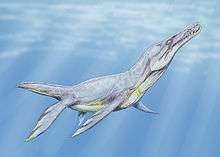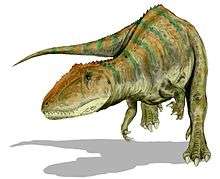Cenomanian
| System/ Period |
Series/ Epoch |
Stage/ Age |
Age (Ma) | |
|---|---|---|---|---|
| Paleogene | Paleocene | Danian | younger | |
| Cretaceous | Upper/ Late |
Maastrichtian | 66.0–72.1 | |
| Campanian | 72.1–83.6 | |||
| Santonian | 83.6–86.3 | |||
| Coniacian | 86.3–89.8 | |||
| Turonian | 89.8–93.9 | |||
| Cenomanian | 93.9–100.5 | |||
| Lower/ Early |
Albian | 100.5–~113.0 | ||
| Aptian | ~113.0–~125.0 | |||
| Barremian | ~125.0–~129.4 | |||
| Hauterivian | ~129.4–~132.9 | |||
| Valanginian | ~132.9–~139.8 | |||
| Berriasian | ~139.8–~145.0 | |||
| Jurassic | Upper/ Late |
Tithonian | older | |
| Subdivision of the Cretaceous system according to the IUGS, as of July 2012. | ||||
The Cenomanian is, in the ICS' geological timescale the oldest or earliest age of the Late Cretaceous epoch or the lowest stage of the Upper Cretaceous series.[1] An age is a unit of geochronology: it is a unit of time; the stage is a unit in the stratigraphic column deposited during the corresponding age. Both age and stage bear the same name.
As a unit of geologic time measure, the Cenomanian age spans the time between[2] 100.5 ± 0.9 Ma and 93.9 ± 0.8 Ma (million years ago). In the geologic timescale it is preceded by the Albian and is followed by the Turonian.
The Cenomanian is coeval with the Woodbinian of the regional timescale of the Mexican Gulf and the early part of the Eaglefordian of the regional timescale of the US eastcoast.
At the end of the Cenomanian an anoxic event took place, called the Cenomanian-Turonian boundary event or the "Bonarelli Event", that is associated with a minor extinction event for marine species.
Stratigraphic definitions
The Cenomanian was introduced in scientific literature by French palaeontologist Alcide d'Orbigny in 1847. Its name comes from the New Latin name of the French city of Le Mans (département Sarthe), Cenomanum.
The base of the Cenomanian stage (which is also the base of the Upper Cretaceous series) is placed at the first appearance of foram species Rotalipora globotruncanoides in the stratigraphic record. An official reference profile for the base of the Cenomanian (a GSSP) is located in an outcrop at the western flank of Mont Risou, near the village of Rosans in the French Alps (département Hautes-Alpes, coordinates: 44°23'33"N, 5°30'43"E). The base is, in the reference profile, located 36 meters below the top of the Marnes Bleues Formation.[3]
The top of the Cenomanian (the base of the Turonian) is at the first appearance of ammonite species Watinoceras devonense.
Important index fossils for the Cenomanian are the ammonites Calycoceras naviculare, Acanthoceras rhotomagense and Mantelliceras mantelli.
Sequence stratigraphy and palaeoclimatology
The late Cenomanian represents the highest mean sea-level observed in the Phanerozoic eon, the past six hundred million years (approximately one hundred and fifty meters above present day sea-levels). A corollary is that the highlands were at all time lows, so the landscape on Earth was one of warm broad shallow seas inundating low-lying land areas on the precursors to today's continents. What few lands rose above the waves were made of old mountains and hills, upland plateaus, all much weathered. Tectonic mountain building was minimal and most continents were isolated by large stretches of water. Without highlands to brake winds, the climate would have been windy and waves large, adding to the weathering and fast rate of sediment deposition.
Palaeontology
Belemnites
| Belemnites of the Cenomanian | ||||
|---|---|---|---|---|
| Taxa | Presence | Location | Description | Images |
Ankylosauria
| Ankylosaurs of the Cenomanian | ||||
|---|---|---|---|---|
| Taxa | Presence | Location | Description | Images |
| Albian or Aptian to Cenomanian | Upper Greensand Group, Cambridgeshire, England | A nodosaurid with an armor of oval plates set almost horizontally into the skin, with spikes protruding from the neck and shoulder area, along the spine. Its size has been estimated to be in the range of 3 to 5.5 meters (10 to 18 ft) long and approximately 380 kilograms (840 lb) in weight. | ||
| Cenomanian to Turonian | Cedar Mountain Formation, Utah, USA | thought of as a nodosaurid ankylosaur, although its precise relationships within that family are uncertain | ||
| Wyoming, Kansas, USA | A nodosaurid ankylosaur about 4 to 6 meters (13 to 20 feet) long with bony dermal plates covering the top of its body. It may have had spikes along its side as well. It had four short legs, five-toed feet, a short neck, and a long, stiff, clubless tail. | |||
| Late Albian to early Cenomanian | Dakota Formation, Kansas, USA | A genus of nodosaurid known from a nearly complete skull. | ||
| Late Albian to early Cenomanian | Frontier Formation, Wyoming, USA | A poorly known genus of nodosaurid | ||
| Baynshiree Svita Formation, Dzun-Bayan, Mongolia | An ankylosaurid known from the remains of its skull | |||
| Chaochuan Formation, Zhejiang, China | Ankylosaurid | |||
| Ruyang, Henan, China | Ankylosaurid | |||
Ornithopoda
| Ornithopods of the Cenomanian | ||||
|---|---|---|---|---|
| Taxa | Presence | Location | Description | Images |
| Cerro Lisandro Formation, Neuquén, Argentina | A small bipedal herbivore, almost seven feet (2 meters) long | |||
| Bihor, Romania | An iguanodont similar to Camptosaurus | |||
| Albian-Cenomanian | Utah, USA | An iguanodont | ||
| Mongolia | ||||
| Cenomanian-Turonian | Bajo Barreal Formation, Chubut, Argentina | A hypsilophodontid or other basal ornithopod, Notohypsilophodon would have been a bipedal herbivore. Its size has not been estimated | ||
| Blackleaf Formation, Montana, and Wayan Formation, Idaho, USA | A burrowing hypsilophodont | |||
| Flower Mound, Texas, USA | A primitive hadrosauroid, Protohadros reached 6 m (19.5 ft) in length and had many hadrosaur-like features | |||
| Cenomanian-Turonian | China | A poorly known iguanodont | ||
Plesiosauria
| Plesiosaurs of the Cenomanian | ||||
|---|---|---|---|---|
| Taxa | Presence | Location | Description | Images |
| Belle Fourche Shale, Wyoming, USA | A pliosaurid characterized by a moderately long symphysis bearing 8 pairs of teeth, teeth that are nearly circular in cross-section and which are smooth on the outer surface (except near the base), ribs of the neck vertebrae being singled-headed (double-headed in Jurassic pliosaurs), and a long slender interpectoral bar on the coracoid |  Plesiopleurodon | ||
Pterosauria
| Pterosaurs of the Cenomanian | ||||
|---|---|---|---|---|
| Taxa | Presence | Location | Description | Images |
| Brazil | An Ornithocheirid pterosaur | |||
Sauropoda
| Sauropods of the Cenomanian | ||||
|---|---|---|---|---|
| Taxa | Presence | Location | Description | Images |
| Andesaurus | Candeleros Formation, Argentina | |||
| Argentinosaurus | Huincul Formation, Neuquén, Argentina | | ||
| Paralititan | Bahariya Formation, Egypt | |||
| Puertasaurus | Pari Aike Formation, Patagonia, Argentina | Originally believed to be from Maastrichtian age. | ||
| Qiaowanlong | China | |||
| Sibirosaurus | Kiya River, Russia | |||
Theropoda
| Theropods of the Cenomanian | ||||
|---|---|---|---|---|
| Taxa | Presence | Location | Description | Images |
| Bahariya Oasis, Egypt; Niger |
| |||
| Morocco; Niger | ||||
| Morocco | ||||
| Candeleros Formation, Argentina | ||||
| Huincul Formation, Argentina | ||||
| Brasil | ||||
| Niger | ||||
| Thailand | ||||
| Cenomanian | Mussentuchit Member, Cedar Mountain Formation, Utah, USA | An 11-12 meter neovenatorid carcharodontosaur known from juvenile remains. Youngest known allosauroid known from North America | ||
| Tafilalt, Morocco | ||||
| Bahariya Oasis, Egypt; Tunisia; Morocco | ||||
| Comahue, Argentina | ||||
|
unnamed enantiornithine bird[4] |
Nammoura, Ouadi al Gabour, Lebanon | |||
References
Notes
- ↑ See for a detailed geologic timescale Gradstein et al. (2004)
- ↑ International Commission on Stratigraphy. "International Stratigraphic Chart" (PDF). Archived from the original (PDF) on 2008-05-29. Retrieved 2008-06-17.
- ↑ The GSSP for the Cenomanian was established by Kennedy et al. (2004)
- ↑ Vecchia, F. M. D.; Chiappe, L. M. (2002). "First avian skeleton from the Mesozoic of northern Gondwana". Journal of Vertebrate Paleontology. 22 (4): 856. doi:10.1671/0272-4634(2002)022[0856:FASFTM]2.0.CO;2.
Literature
- Gradstein, F.M.; Ogg, J.G. & Smith, A.G.; 2004: A Geologic Time Scale 2004, Cambridge University Press.
- Kennedy, W.J.; Gale, A.S.; Lees, J.A. & Caron, M.; 2004: The Global Boundary Stratotype Section and Point (GSSP) for the base of the Cenomanian Stage, Mont Risou, Hautes-Alpes, France, Episodes 27, pp. 21–32.
External links
- GeoWhen Database - Cenomanian
- Late Cretaceous timescale, at the website of the subcommission for stratigraphic information of the ICS
- Stratigraphic chart of the Lower Cretaceous (including the Cenomanian), at the website of Norges Network of offshore records of geology and stratigraphy
- Cenomanian Microfossils: 20+ images of Foraminifera
| Cretaceous Period | |
|---|---|
| Lower/Early Cretaceous | Upper/Late Cretaceous |
| Berriasian | Valanginian | Hauterivian Barremian| Aptian | Albian |
Cenomanian | Turonian | Coniacian Santonian |Campanian | Maastrichtian |
Coordinates: 44°23′33″N 5°30′43″E / 44.39250°N 5.51194°E



